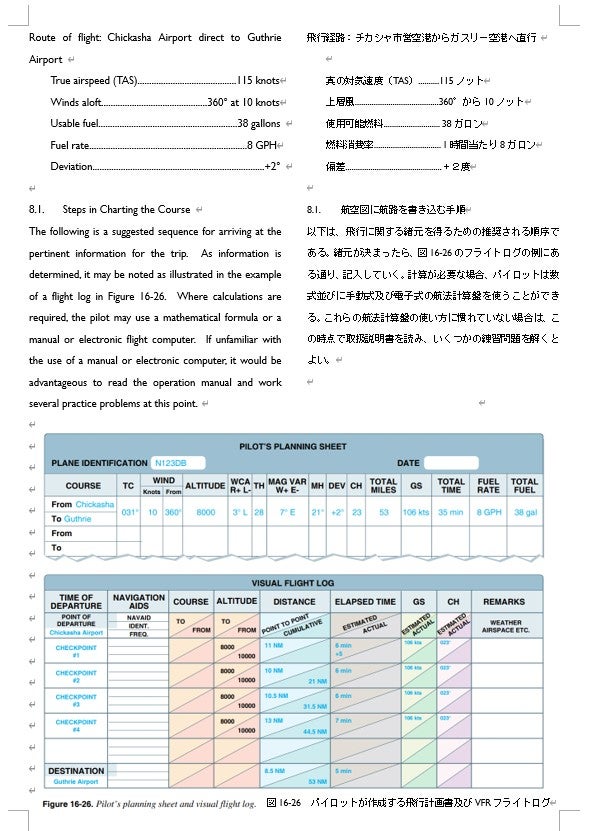2.7 (1) The Second Stage Check
<The Second Stage Check>
Right now, my objective is to fly solo cross-country flight of two kinds. One is a short round trip taking a little less than one hour each, called a short cross-country. The other is a long one having three destination airports with longer total distance, called a long cross-country.
To that end, I had to pass the Second Stage Check. This includes a cruise flight using a VOR facility, which I am not good at, and others as well as takeoffs and landings.
As for the first stage check for a solo traffic pattern flight, I had a miserable experience. I was too nervous. Since then, however, I have gained a lot of flight experiences laughing and crying, removed unnecessary “negative veil” understanding who I am. This made me mentally (a little) resilient. Above all, there were no airworks included in the second stage check, which was good. Unlike the previous one, I passed the stage check with no difficulty.
<Planning for Emergency Situatioins>
On the day when I passed the Second Stage Check, my first solo short cross-country flight was scheduled three days later. This one is not so hectic because of a short distance simple round trip. It would be OK with careful check of the weather data in the morning, detailed NAV LOG prepared, and once again final review.
From My PHAK Translation Notebook
As airplanes used for a Private Pilot License (PPL) training are usually single engine aircraft., if engine failure occurs, it is highly likely that we need forced landing. Therefore, during ground school or slight training, we often discussed how to plan and prepare for an emergency situation.
For example, if engine failure occurs just after taking off, what a benchmark altitude is, at or above which we may fly back to the departing runway, otherwise a forced landing off the airport will be necessary. I also planned emergency sites in case of engine failure on the cruising route for the coming cross-country flight. Airports are the best for the site, but there were a portion without any airport as a reasonable emergency site on the route considering the Maximum Glide Distance. I tried to find a flat site for that portion.
One day, when flying traffic pattern, the instructor suddenly reduced power to idle at the abeam on the downwind leg. He said, “Engine failure, what should you do?” It was too sudden that I was at a loss, but I only had to deal with it.
While asked if I could reach the runway, I was instructed how to deal with that situation. It was my first experience to turn downwind to base with engine idle. It was like feeling I weighed less, or my aircraft was landing gently like a butterfly.
Then, my instructor said, “I want you to survive whatever will happen,” which was so impressive. I will have to deal with everything myself to survive whatever will happen while flying alone. Instructors have been working so hard to give us instructions so that we can safely fly alone.
Another impressive instruction happened during a takeoff run. The instructor abruptly reduced power to idle, saying, “Engine failure, what would you do?” In this case, I leaned about the emergency procedures in the ground school, I tried to do as instructed. It was so exciting that I realize what I learned about while flying because my mind and action are properly connected, which is, in another word, “I am doing what I think is right.”
<Checkride is Coming Soon!>
The checkride has been scheduled three weeks later at an airport about 30 miles away from our base airport. The flight training has been a little changed so as to respond to the examiner’s unique questions etc. As always, the instructor orders a specific kind of takeoff or landing just before doing. There were also detailed instructions for more precise altitude maintained in entering the traffic pattern in arrival procedures or review of flights with VOR to finalize for a satisfactory flight having the checkride in mind.
The checkride include an oral portion in addition to a flight portion. The student pilot peers who are expected to take a checkride at almost the same day have already begun to study for an oral exam. One of them even showed off what he was studying in front of the white board at the school. I tried not to be affected keeping my own pace, considering that I had more difficulty in a flight portion compared with an oral portion. So I decided to start to study for an oral exam a few days later more focusing on flight review. For better or worse? No one knows. (continued)

